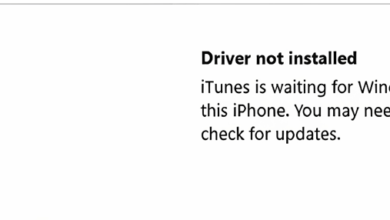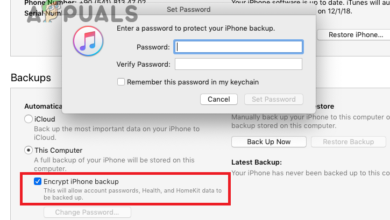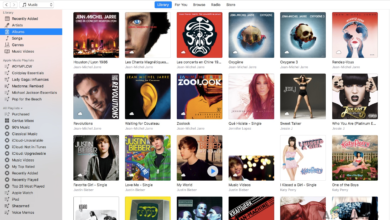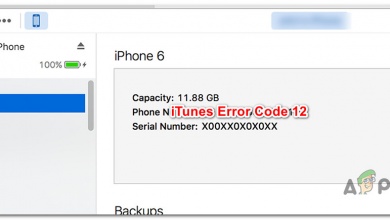8 Fixes: ‘iTunes detected a problem with your audio configuration’
iTunes is the flagship software released by Apple to support music, video from your iDevice as well as allow you to transfer content between them. The application has become a symbol for Apple software excellence and users even use it if they don’t have any iDevice at all.

Despite active development and being one of the flagship software products of Apple, iTunes also experiences numerous issues in its operation which includes the error message ‘iTunes has detected a problem with your Audio Configuration’. This error is very common and either comes up when you launch the application or when you try any music/video. In this article, we will go through all the reasons as to why this occurs on your computer and what the possible workarounds are to fix the problem.
What causes the error message ‘iTunes had Detected a problem with your Audio Configuration’?
After analyzing several reports, we resorted to experiments on our own devices. After extensive research and cross-checking, we concluded that the error occurred due to several reasons. Some of them are but not limited to:
- Speakers bug: One of the interesting bugs we came across was where unless you plugged in some external speaker device, the application failed to load up and caused the error message.
- Missing drivers: Most people tend to ignore this but the drivers of their sound devices tend to be missing. Installing the missing drivers usually solves the problem.
- Outdated/corrupt drivers: Even if the drivers are installed on your computer, they might be outdated or corrupt. Updating them to the latest ones might help.
- Windows Audio Service: This service is the main service running on your computer responsible for running the audio on your computer and managing different sources. If it is acting up, so will the applications using it.
- Incorrect default sound device: Windows has a setting where you can select the default device which your computer will give preference when running sound. If the correct device is not set as the default device, you will experience numerous issues.
- Firewalls: Firewalls don’t usually interfere with these internal operations of the computer but it turns out some do. Disabling the Firewall and checking might help your case if this is true.
- Playback preferences: iTunes also has playback preferences which choose the preferred device to output the sound to. If none works, we can try changing the playback preference and see if this helps our case.
- QuickTime: QuickTime is a media player also developed by Apple and it plays a major part in running the iTunes sound. If QuickTime is not installed properly or is lacking installation files, you might experience issues.
- Outdated OS: This fact can never be ruled out; if your very operating system is outdated, issues might arise regarding the compatibility of different applications.
- Bad update: We noticed that in some cases, users reported that a potential Windows update created problems for them. Restoring might help here.
Before we start with the solutions, make sure that you have an active internet connection on your computer. Furthermore, you should also have administrator access as we will performing some system-related changes.
Solution 1: Plugging in Audio Device
The first thing which we will try is plugging in some audio device on your computer. It seems that iTunes has a bug where if you don’t have any audio device plugged in, the application will throw an error and refuse to load any media.

This seems bizarre because even if there is no audio device available, the application should only transmit sound to the drivers who should handle everything from there. Nevertheless, try plugging in headphones/audio jack in your computer and make sure that it is detected. After it is, try launching the application again and check if the issue at hand is resolved.
Solution 2: Restarting Audio Services
Windows Audio is the main service which is running on your computer in your services tab. It is responsible for managing all the audio in your computer as well as making sure that the information is being transmitted to the Audio drivers on your computer. However, if the audio services are in an error state and not responding properly, you might experience the error message.
In this solution, we will navigate to Windows Services and restart the Windows Audio service.
- Press Windows + R, type “servicesmsc”, and press Enter.
- Once in services, navigate through all the entries until you find “Windows Audio”. Right-click on it and select “Restart”.

Restarting Audio Services - Now right-click the entry again and select “Properties”. Set the startup type as “Automatic”. Press Apply to save changes and exit.

Setting Service as Automatic - Once done, launch iTunes again and check if the error message is resolved for good.
Solution 3: Setting the Correct Default Device
Windows has a setting from where you can select the default device which should be given preference when sound is being outputted. Normally, the default device is set automatically by Windows which leads to some cases where the correct default device is not marked as such. In this article, we will navigate to your Playback devices settings and make sure that the correct device is set.
- Right-click on the speaker icon on your taskbar and select “Open Sound settings”.

Sound settings – Windows - Once in Sound settings, click on Sound Control Panel under the tab of Related Settings.

Sound Control Panel - Right-click on “Speakers” and select “Set as Default Device”. Press OK to implement changes and exit.

Setting as Default Device - Now restart your computer so all the changes are applied and check if the issue is resolved for good.
Solution 4: Disabling Antivirus/Firewall Software
All Antivirus software attempt at keeping your system secure and safe by blocking all applications that they consider are harmful to your system. In this ‘protection’, some applications which are indeed legitimate might be flagged (this is known as a false positive) and their actions blocked or them being given limited access.

Same is the case with iTunes; some Antivirus/firewall applications attempt at blocked the full access of iTunes on your computer. Hence, we recommend that you disable your Firewalls and Antivirus software installed on your computer. You can check out our article on How to turn your Antivirus off. After disabling your Antivirus, restart your computer and try streaming again. If disabling the Antivirus doesn’t work, you can try uninstalling it and see if it does the trick for you. Some noticeable Antivirus software which was causing issues was Avast and AVG.
Solution 5: Changing iTunes Playback Preferences
iTunes also has preferences set from where you can set the preferences of the application including the option on which sound device to prefer when it is transmitting sound. If all the above methods check out, the issues probably lie within iTunes itself. In this article, we will navigate to iTunes preferences and change the setting from there. You can always revert the changes whenever needed.
- Launch iTunes on your computer. Now, click on Edit and select Preferences from the drop-down.

Preferences – iTunes - Once the Playback preferences open up, click on the Playback button present at the top-bar.

Changing Playback settings - Now, scroll down and on the option of Play Audio Using, select Direct Sound instead of Windows Audio Session.
- Save changes and exit. Restart your computer and launch iTunes again. Check if the issue is resolved.
Note: You can always tinker around the settings of the application and see which setting works for you.
Solution 6: Reinstalling QuickTime
QuickTime is a multimedia platform which is developed by Apple itself. Its main goal is to supplement the normal sound drivers installed on your computer and allow applications like iTunes to smoothly transmit audio without any issues. However, if QuickTime isn’t installed properly on your computer or is incomplete, you might experience numerous issues including iTunes throwing the error. In this solution, we will navigate to the application manager and first uninstall the application. Then we will install the latest version and see if this solves the problem.
Note: If you don’t already have the application installed, skip directly to the installation part.
- Press Windows + R, type “appwiz.cpl” in the dialogue box and press Enter.
- Once in the application manager, search for Quick Time. Right-click on it and select Uninstall.

Uninstalling old QuickTime - After the software is uninstalled, restart your computer. Now, navigate to the official Quick Time application

Downloading Latest QuickTime and download the latest version of the application to an accessible location.
- Install the application, restart your computer and check if the issue is resolved.
Solution 7: Reinstalling Audio Drivers
It is also essential that we check whether the audio drivers on your computer are valid and indeed installed. If they aren’t, you will experience numerous issues ranging from applications not working to them giving an error message.
In this solution, we will first uninstall your audio drivers and then attempt at installing the default ones. If the default drivers don’t work, we will navigate to the automatic update functionality and update the drivers there. If even that doesn’t work, we will navigate to your manufacturer’s website and install the drivers from there. Make sure that you are logged in as an administrator before proceeding.
- Press Windows + R, type “devmgmt.msc” in the dialogue box and press Enter.
- Once in the device manager, expand the category of Audio inputs and outputs, right-click on your sound device and select Uninstall Device.

Uninstalling Old Audio Drivers - Now, wait for a few seconds. Now, right-click on any space on the device manager and click Scan for hardware changes.
Windows will now start scanning for undetected hardware which is connected to your computer. Of course, it will notice that the sound device doesn’t have the driver and it will install the default drivers.
After the sound device is detected, relaunch the application and check if the error is resolved for good. If it doesn’t, move on where we install the latest drivers available.
- Right-click on the sound hardware and select Update Driver.

Updating Driver - Now there will be two options available to you. Either you can update automatically or manually after selecting from the list of directories. We recommend that you try updating automatically at first and see if this works.

Downloading latest drivers through WU
If you cannot install the latest drivers through Windows update (this is very common), then you can move on and access the manufacturer’s website and navigate to the driver’s section. Search for your audio device model and download the drivers to an accessible location. Right-click on it and select Run as administrator. Don’t forget to restart your computer before testing iTunes again.
Solution 8: Updating Windows to the Latest Build
If none of the above methods work, we will check and make sure that your operating system is updated to the latest version. Microsoft engineers launch frequent updates for its products now and then to introduce new features and fix existing bugs. Same is the case with Apple. Whenever Windows updates its operating system, Apple releases updates for its application itself for maximum compatibility (even though there is always backward compatibility but it is known to be troublesome in some cases).
Both, your iTunes and Windows should be updated to the latest version because if there is a mismatch between the applications, you will experience numerous issues including the audio configuration error message.
Here is the method on how to update Windows to the latest version.
- Press Windows + S, type “update” in the dialogue box and launch the Settings app.
- Now, click on the button of Check for Updates. If there is already an update available, download and install it.

Updating Latest Windows Version - After the updates are installed, restart your computer and launch iTunes. Check if the issue is resolved.

Downloading Latest iTunes
You should also make sure that iTunes is updated to the latest version on your computer. Usually, Apple runs a service named Apple Update Service on Windows. You should run it and see if there are any updates available. If this isn’t available, navigate to the official iTunes website and install the latest version manually.





